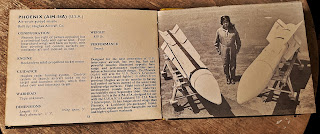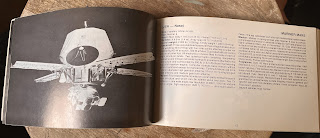One such pocket sized guide were the Bancroft Tiddlers range of books, which naturally included a space edition. Tiddlers were literally pocket sized, about 3” x 2” and comprised of about 30 colour pages. ‘Secrets of Space’ was released in the mid sixties and includes all the usual suspects up to Apollo.
Drawings of planets, rockets and satellites - Mariner gets good coverage as the first close up images of Mars were appearing about this time.
As was always the case with any space book, the latter part includes a look to the future and an ‘Orbital Glider’ - the shuttle hadn’t reached the drawing board yet.
Next up and similar in size and format, is the Odhams book of Space, given away with orange cordial and small enough to be attached to the bottle.
Despite having a landscape cover, the interior shifts to portrait orientation and includes a nice mix of photographs and painted illustrations.
Moving up in scale to properly bound books, we have Hippo Books ‘Rockets and Missiles’. Slightly larger at 4” x 3” and with a considerably higher page count, the book is a handy reference for all major rockets in service to about 1971.
All the interior is printed in black and white, with technical details and a photograph. Some of the Cold War era ones are sometimes a little fuzzy, due to the difficulty in obtaining reliable material in the West.
Now to the most famous series of reference pocketbooks, the Jane’s series. Starting at No.10 Missiles.
Similar in format and size to the previous, the Jane’s series are considered one of the best records of technical information for military and aerospace subjects.
The Missiles volume doesn’t disappoint either, with plenty of technical data and good quality photographs.
It includes some quite unusual and rare missiles, used in service by many different countries.
Number 11 in the Jane’s series is Space Exploration, a soft back version from 1975.
Again, it is a copious reference for spacecraft from around the globe, with technical data and details.
Finally, we have volume 12 Research and Experimental Aircraft, which concludes the trinity of space themed volumes.
Some of the aircraft included in the book did not make it past the experimental stage and were classed as secret projects for a long time, but this did not stop toymakers using the designs to produce toys. Marx toys released a large model of the TSR 2 jet and the Bristol 188.
Even one of the oddest aeroplanes ever designed, the SNECMA Coleoptere with its annular wing, found its way into the world of toys.

Some of the experimental jets would not look out of place in a Gerry Anderson show.
Again, an international showing of aircraft is included, with excellent photo reference for most of the book, hampered only by a scarcity of information on some of the soviet listings.













































